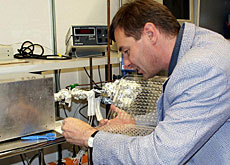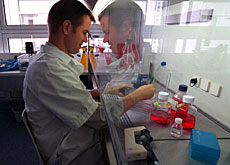Science of the small poses big dilemma

Campaigners on both sides of the nanotechology divide are calling for more dialogue about the benefits and risks of a field that is beginning to revolutionise science.
Nanotechnology is the manipulation of particles at the nanoscale – one-millionth of a millimetre.
Supporters in Switzerland say the discipline has the potential to create huge benefits in areas such as medicine, electronics, chemistry and computing.
Critics say we need to understand whether it raises new ethical, health and safety or social issues before we go any further.
“It’s clear that as scientists we also have to face the negative side of our activities and it is absolutely clear that we have to be aware of the risks of our work,” said Jörg Patscheider of the Federal Laboratories for Materials Testing and Research (Empa) in Dübendorf.
Size matters
Companies and university departments in Europe, the United States and Japan are investing millions in manipulating matter at the scale of individual atoms and molecules.
Research into extremely small devices is still in its early stages, but consumers can already buy products based on the new technology, such as transparent sunscreen and stain-resistant textiles.
Scientists are investigating food packaging that changes colour when the food inside starts to spoil and bandages that can detect infection.
Hopes are high that the new science could lead to more efficient drug delivery, faster computers with greater data storage and new materials such as self-cleaning glass.
Backlash
Despite the advances, no one really knows what the long-term effects of manipulating matter at the atomic level will be.
The limited research available reveals that the toxicity of nanoscale particles of any substance is considerably greater than a macro scale amount of the same substance
A new generation of suncreams is using tiny particles of metal oxides, which cut out ultra-violet rays but do not have to be applied in thick, white layers.
However, it is feared these ultra-fine chemicals can pass through the skin and damage the DNA of cells.
Meanwhile, those who work with nanotubes – tiny, cylindrical carbon-based molecules – face the risk of serious lung damage through inhalation.
“Nobody knows at the moment what happens if these particles pass from the lung into the blood,” Christoph Meili of the Risk Dialogue Foundation in St Gallen told swissinfo.
Privacy
Another uncertainty is what happens when synthetic nanoparticles are released into the environment or get into our food supply.
“The fears have to be taken seriously and you have to prove that the risks of using such products are minimal,” said Jörg Patscheider.
Other concerns have been raised about privacy because nanotechnology offers the possibility of invisible microphones, cameras and tracking devices,
One apocalyptic vision even has self-replicating robots getting out of control and turning the planet into grey goo, though most nanotechnologists believe tiny robots are unlikely to be part of our lives for at least another 100 years.
Past mistakes
Meili said the fear was that we would repeat the mistakes made over biotechnology and genetically modified (GM) foods.
GM products were already commercially established before regulation came into effect.
“We have learnt from previous debates that the dialogue must be started very early,” he said. “Nanotech products are already on the market and there isn’t any dialogue yet.”
“I think we need regulation and greater awareness,” added Zurich-based philosopher Klaus Peter Rippe.
“Nanotechnology is with us today. I think there should be more information for consumers.”
Under the microscope
In Canada, environmental campaigners have called for a moratorium on the new science.
Earlier this month, the British government launched an independent study into the benefits and risks of nanotechnology.
Meanwhile, spending is growing fast. Switzerland makes about $20 million available each year for research in nanotechnology and related fields.
In the US, more than $700 million has been earmarked for 2003. Japan has launched a ten-year $100 million nanotechnology research programme.
Investigating the nanoworld became a reality in the 1980s when scientists at IBM’s Zurich research laboratory invented a microscope that could see on the atomic scale.
The discovery won them a Nobel prize in physics.
swissinfo, Vincent Landon
Nanotechnology is the manipulation of particles, which are millionths of a millimetre in size.
A single human hair is around 80,000 nanometres in width.
At this scale, the electrical, physical and chemical properties of a material can change dramatically.
Some forecasters says nanotechnology could bring us tremendous benefits.
Others claim it could run amok and devastate our world.

In compliance with the JTI standards
More: SWI swissinfo.ch certified by the Journalism Trust Initiative



You can find an overview of ongoing debates with our journalists here. Please join us!
If you want to start a conversation about a topic raised in this article or want to report factual errors, email us at english@swissinfo.ch.